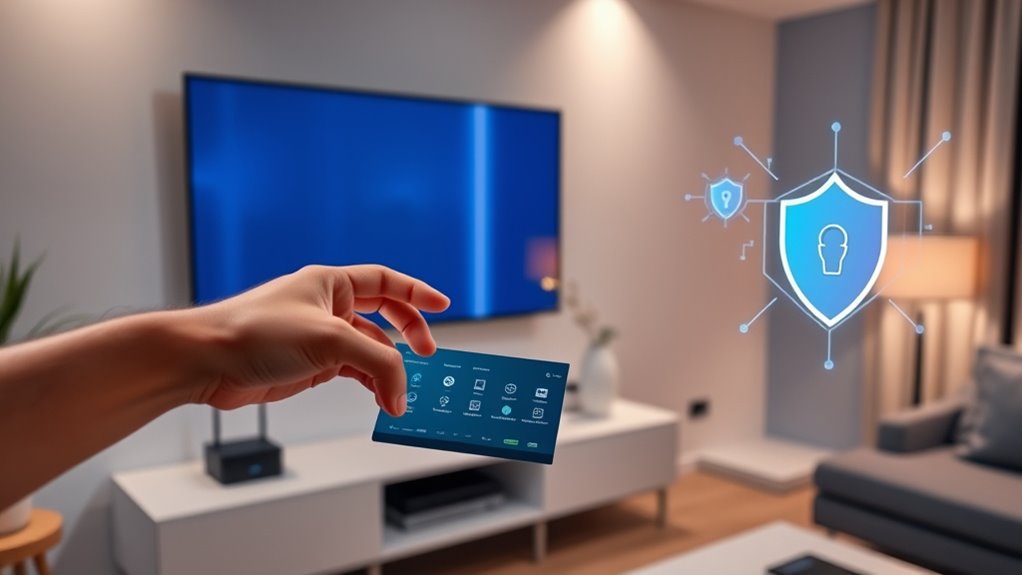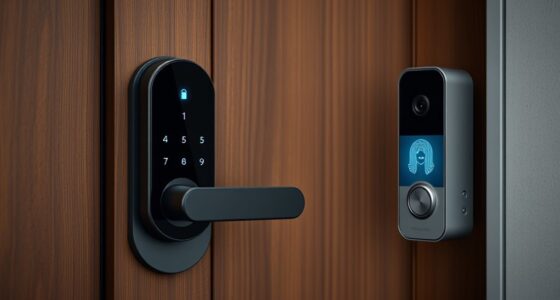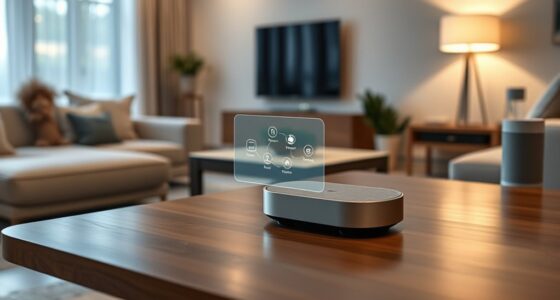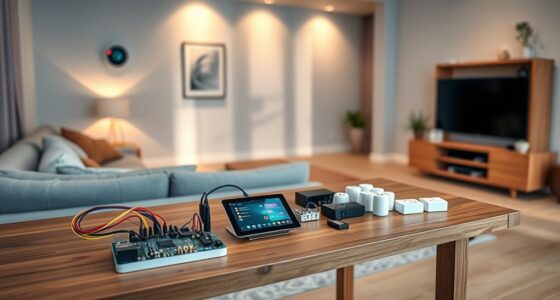To protect your smart home from hackers, keep all your device software and firmware up to date, and use strong, unique passwords for each device. Enable two-factor authentication when possible, and regularly review device access permissions. Secure your Wi-Fi with robust encryption, and consider network segmentation to limit access. Monitor network traffic for suspicious activity, and back up your data frequently. Staying informed about the latest security practices will help you stay ahead—there’s more to learn to keep your home safe.
Key Takeaways
- Regularly update device firmware, software, and apps to patch security vulnerabilities.
- Use strong, unique passwords and enable two-factor authentication for all smart devices.
- Segment your network with VLANs to isolate smart devices from main networks.
- Manage device access permissions, remove unused devices, and disable unnecessary features.
- Monitor network traffic for suspicious activity and stay informed about the latest cybersecurity practices.
Keep Software and Firmware Up to Date
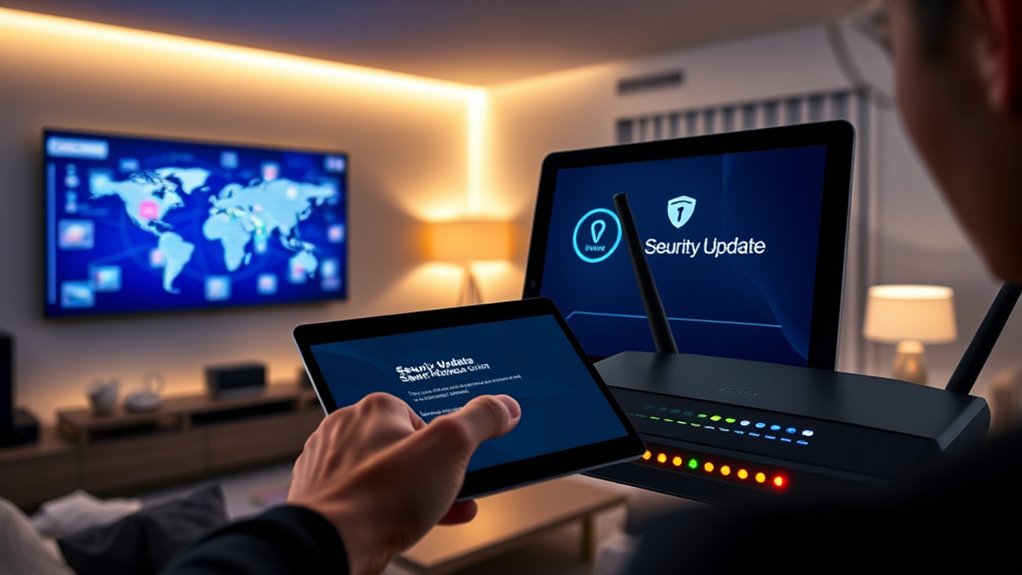
Keeping your smart home devices up to date is vital for security. The software update significance can’t be overstated, as it ensures your devices have the latest protections against vulnerabilities. Regular updates fix security flaws, improve functionality, and prevent hackers from exploiting outdated software. Firmware patch management is a key part of this process, as it addresses hardware-specific issues that software updates might not cover. By staying current with updates, you reduce the risk of unauthorized access and potential breaches. Many devices automatically notify you of updates, but it’s wise to check manually periodically. Neglecting this step leaves your network exposed to known threats. Prioritize timely updates to keep your smart home safe, secure, and running smoothly. Updating firmware regularly helps maintain optimal device performance and security, especially since firmware updates often include critical security patches that protect against emerging threats.
Use Strong, Unique Passwords for All Devices

To protect your smart home devices from unauthorized access, you need to use strong, unique passwords for each one. Relying on the same password across multiple devices risks a security breach if one gets compromised. Implement effective password management by generating and storing unique credentials for every device. Use tools or password managers that facilitate unique credential generation, making it easier to create complex, unpredictable passwords. Avoid simple or common passwords like “password123” or “admin,” which are easy for hackers to guess. Regularly update your passwords and don’t reuse old ones. This approach guarantees each device remains protected, and if one password is compromised, other devices stay secure. Strong, unique passwords are a crucial step in safeguarding your smart home. Additionally, being aware of the security features built into your devices can further enhance your protection efforts. Ensuring your network is properly secured with a strong Wi-Fi password adds an extra layer of defense against potential intruders. Incorporating mindfulness techniques into your security routine can help you stay vigilant and proactive in maintaining a secure smart home environment. Regularly reviewing your device settings and privacy policies can also help you stay informed about how your data is protected and ensure your security measures are up-to-date. Staying informed about emerging cybersecurity threats can help you adapt your protection strategies effectively.
Enable Two-Factor Authentication When Available
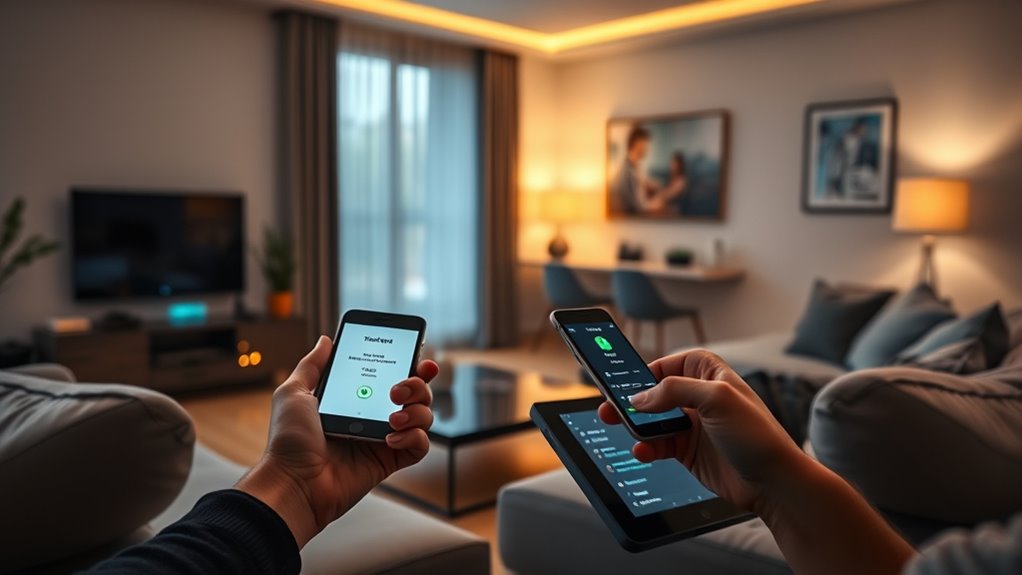
Enabling two-factor authentication (2FA) adds an essential layer of security to your smart home devices by requiring a second form of verification beyond just a password. This process enhances device authentication, making it harder for hackers to gain access even if they compromise your password. When available, turn on 2FA for your smart home apps and accounts, such as those controlling your security cameras, locks, or lighting. Typically, 2FA involves entering a code sent to your phone or email, adding a safeguard against unauthorized access. By activating this feature, you markedly reduce the risk of someone hijacking your devices or spying on your home. Always opt for two-factor authentication whenever it’s available to strengthen your overall smart home security. Privacy and Cookie Usage considerations highlight the importance of safeguarding your device data and personal information from unauthorized access.
Segment Your Network for Enhanced Security
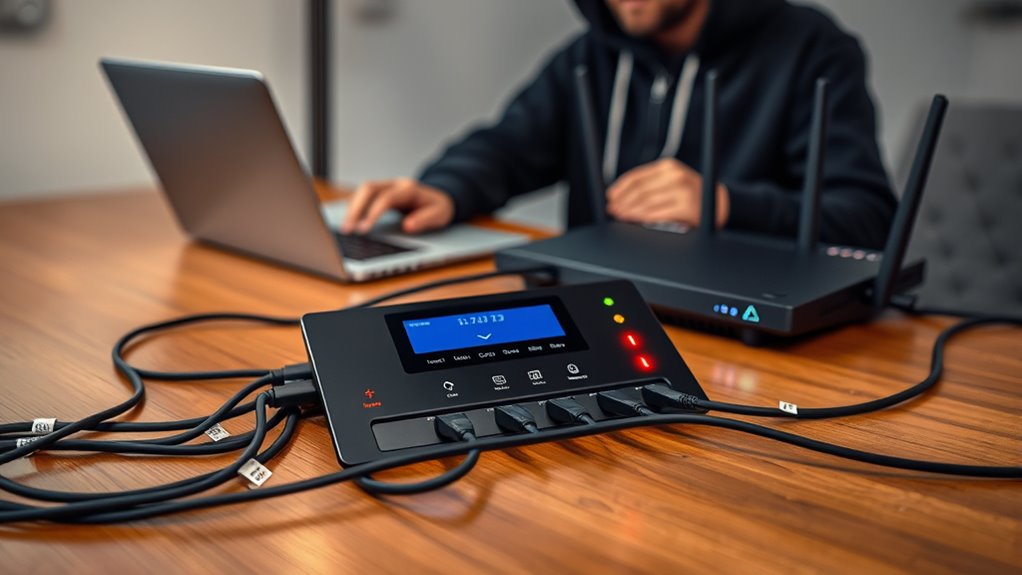
To improve your smart home security, you should create separate network segments for different devices. Limiting how devices connect with each other reduces potential attack paths. Using VLANs can help isolate sensitive devices from less secure ones, adding an extra layer of protection. Incorporating regular security assessments ensures that your network remains protected against emerging threats. Additionally, keeping your device firmware and software up to date is crucial for patching vulnerabilities and maintaining security. Regularly reviewing your network configuration helps identify and address potential weaknesses before they can be exploited, especially as new threats emerge. Conducting ongoing risk assessments helps you stay aware of evolving security challenges and adapt your defenses accordingly.
Create Separate Network Segments
Creating separate network segments is a crucial step in strengthening your smart home security. By implementing network segmentation, you limit access between devices, reducing the risk of a breach spreading. Using virtual LANs (VLANs), you can isolate your smart devices from your main network, ensuring sensitive data stays protected. This setup prevents hackers from moving laterally if they compromise one device. Additionally, understanding Fokos helps inform better security practices for managing your networks.
Limit Device Interconnections
Limiting device interconnections is essential for enhancing your smart home security because it prevents unauthorized access and limits the spread of potential breaches. By controlling device interconnection, you reduce the chances that a compromised device can communicate with others, containing any security issues. Implement network segmentation to isolate sensitive devices, such as security cameras or smart locks, from less secure gadgets like smart bulbs or speakers. This way, even if an attacker gains access to one device, they won’t easily move laterally across your entire network. Proper device interconnection management ensures that your smart home remains resilient against hackers, restricting their ability to exploit vulnerabilities and keeping your data safe. Focus on segmenting your network to strengthen overall security and protect your connected devices. Additionally, understanding Smart Home Market Growth trends can help you stay informed about emerging security challenges and solutions. Incorporating network segmentation best practices can further enhance your defense against cyber threats and security awareness helps in recognizing potential vulnerabilities before they are exploited.
Use VLANs for Isolation
Implementing VLANs (Virtual Local Area Networks) allows you to segment your smart home network effectively, isolating sensitive devices from less secure ones. VLAN segmentation creates separate virtual networks within your physical network, helping prevent a compromised device from accessing critical systems. By isolating smart locks, security cameras, and personal data on their own VLAN, you enhance network isolation and reduce the risk of hackers moving laterally across devices. This setup limits potential attack vectors and contains breaches, so even if a device is compromised, the rest of your network remains protected. Configuring VLANs may require some technical knowledge, but it’s a powerful way to strengthen your overall smart home security. Incorporating network segmentation is an effective strategy to further limit access and contain potential threats. Use VLAN segmentation as a proactive measure to keep your smart home safe.
Regularly Review Device Access and Permissions
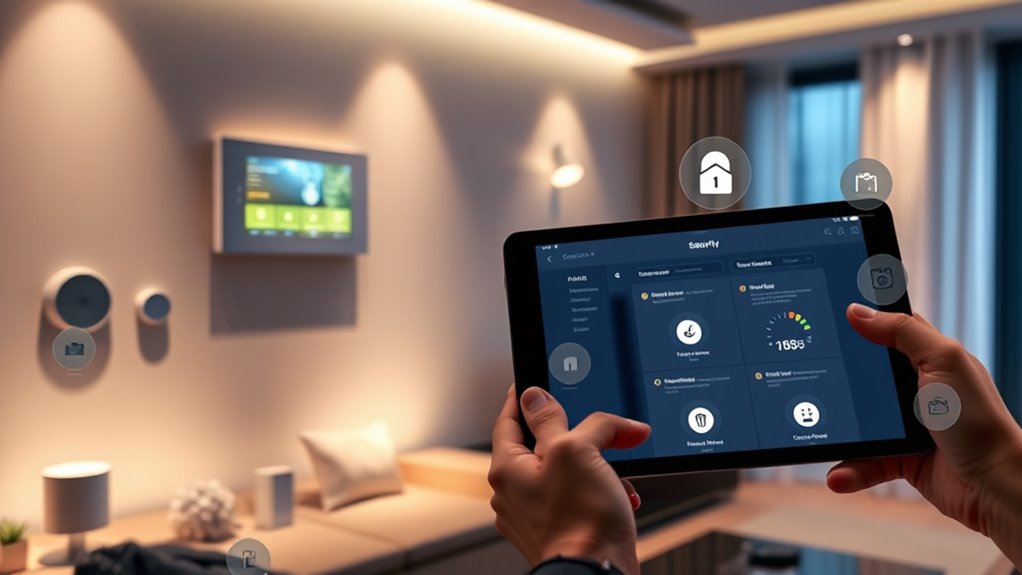
You should regularly check who has access to your smart devices and what permissions they have. Removing unused devices and updating access rights keeps your network secure. Staying vigilant helps prevent unauthorized access and potential security breaches. Implementing penetration testing techniques can help identify vulnerabilities in your smart home setup before malicious actors do. Additionally, staying informed about industry trends can help you anticipate emerging threats and strengthen your defenses. Regularly monitoring device security settings ensures that any unauthorized changes are promptly detected and addressed, further safeguarding your smart home environment. Recognizing the importance of fatherly guidance in cybersecurity can foster a proactive attitude toward safeguarding your digital spaces. Incorporating powerful persuasive words into your security communication can also encourage better user practices and awareness.
Audit Device Access Rights
How often do you review the access rights of your smart home devices? Regularly auditing device access guarantees only authorized users can control your smart home. Start by examining your permission management and adjusting device access as needed. An effective approach involves listing devices, verifying who has access, and removing unnecessary permissions. To make this process smoother, consider this table:
| Device Type | Current Access Level | Action Needed |
|---|---|---|
| Smart Lock | Family members, guests | Remove guest access if expired |
| Security Camera | Homeowner, security service | Confirm authorized personnel |
| Thermostat | Family members | Limit access for temporary users |
| Voice Assistant | All household members | Restrict external integrations |
Remove Unused Devices
Regularly reviewing your smart home devices is essential to maintaining security and efficiency. Disconnect any unused gadgets or devices you no longer need, as they can become entry points for hackers. Unused gadgets may still have access permissions or vulnerabilities, so removing them reduces potential risks. Check your device list periodically and disable or delete disconnected devices that aren’t active. This helps prevent unauthorized access and keeps your network streamlined. Leaving unused devices connected or with lingering permissions can compromise your entire smart home system. By proactively removing these devices, you minimize security gaps and ensure only authorized gadgets remain connected. Staying vigilant about unused gadgets is a simple but effective step toward protecting your smart home from potential threats.
Update Permissions Regularly
After removing unused devices, it’s important to review and update their access permissions. Regular permission management ensures only authorized users have control over your smart home devices. Check who has access and remove any unnecessary permissions to strengthen your access control. This prevents potential security breaches caused by outdated or excessive permissions. Remember, permissions can change over time, especially when people move or no longer need access. By routinely updating device access, you reduce the risk of hackers exploiting vulnerabilities. Keep your permissions clear and current, and limit control to trusted individuals. This ongoing process helps maintain a secure smart home environment, making it harder for intruders to gain unauthorized access. Regular permission updates are a simple yet essential step in protecting your connected home.
Disable Unnecessary Features and Services
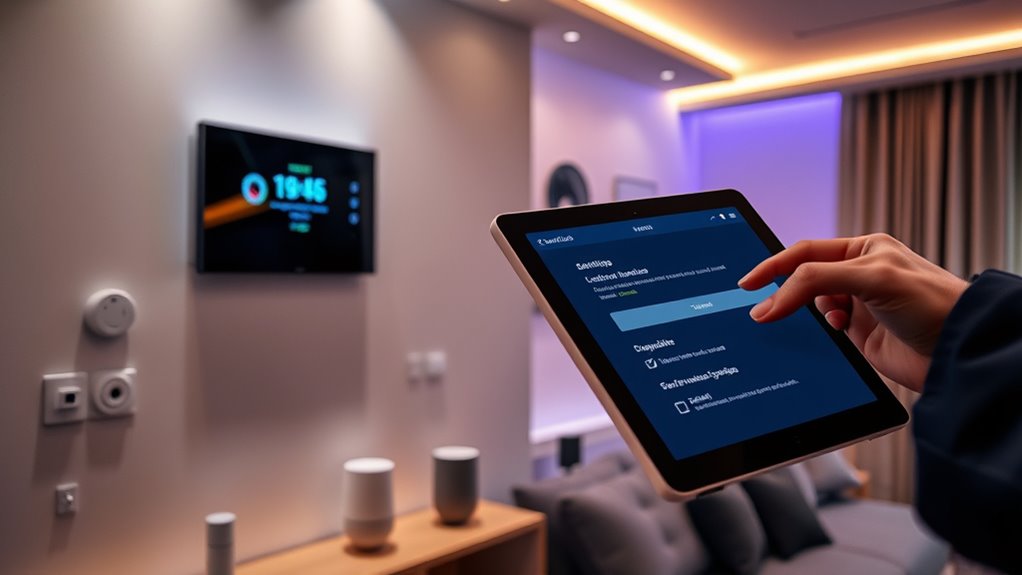
Disabling unnecessary features and services on your smart home devices reduces potential security vulnerabilities and minimizes the risk of unauthorized access. Start by turning off voice assistants when you don’t need them, as they can be exploited to eavesdrop or send data without your knowledge. Disabling camera microphones is also vital; if you don’t use the microphone feature, turn it off to prevent hackers from listening in. Review your device settings and disable any services or features that aren’t essential for your daily use. This includes auto-updates or remote access options that aren’t necessary. By limiting active features, you reduce the attack surface and make it harder for hackers to exploit vulnerabilities in your smart home system.
Secure Your Wi-Fi Network With Robust Encryption
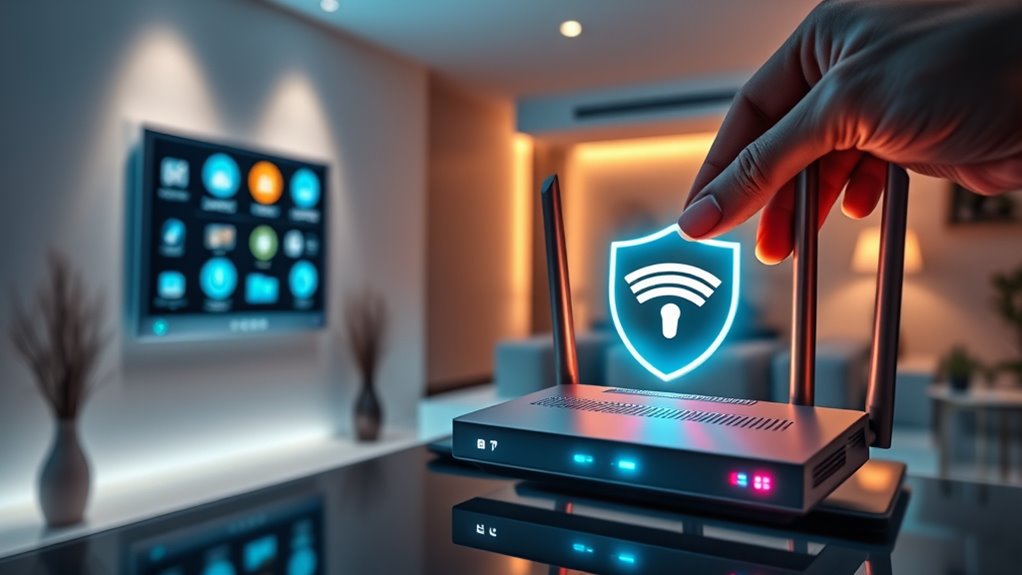
To keep your smart home secure, you need to protect your Wi-Fi network with strong encryption. Using a robust password makes it harder for intruders to access your devices, while enabling network encryption guarantees your data stays private. Don’t overlook these steps—they’re essential for safeguarding your smart home.
Use Strong Passwords
Securing your Wi-Fi network begins with using a strong, unique password that’s difficult for others to guess. Focus on password complexity by combining uppercase and lowercase letters, numbers, and symbols. Avoid common words or easily guessable information like birthdays. Regularly updating your passwords and managing them with a reliable password manager helps prevent weak or reused passwords from compromising your network. A robust password acts as a first line of defense against unauthorized access, reducing the risk of hackers infiltrating your smart home. Remember, simple or default passwords are easy targets, so take the time to craft a complex, memorable one. Proper password management ensures you maintain security without sacrificing convenience, keeping your devices and data safe from cyber threats.
Enable Network Encryption
Have you enabled robust network encryption on your Wi-Fi to protect your smart home? Wireless encryption is essential for preventing hackers from intercepting your data or gaining unauthorized access. Make sure your router uses WPA3 or at least WPA2 encryption, which encrypts the data transmitted over your network. Additionally, focus on password complexity—use a strong, unique password that combines uppercase and lowercase letters, numbers, and symbols. Avoid common words or easily guessable information. This combination of strong wireless encryption and complex passwords creates a formidable barrier against intrusion attempts. Regularly update your router’s firmware to maintain security standards. By enabling these measures, you considerably reduce the risk of cyber threats targeting your smart home network.
Monitor Network Traffic for Suspicious Activity

Monitoring your network traffic is essential for detecting any suspicious activity that could compromise your smart home security. By performing traffic analysis, you can identify unusual patterns or unexpected device connections that may signal hacking attempts. Anomaly detection tools help flag deviations from normal network behavior, alerting you to potential threats early. Regularly reviewing your network logs allows you to spot unauthorized access or data transfers. Implementing real-time monitoring ensures you’re immediately aware of suspicious activity, so you can act swiftly. Keeping an eye on your network traffic not only enhances security but also helps you understand device communication, reducing vulnerabilities. Staying vigilant with traffic analysis and anomaly detection gives you control over your smart home’s safety.
Implement a Comprehensive Backup Strategy
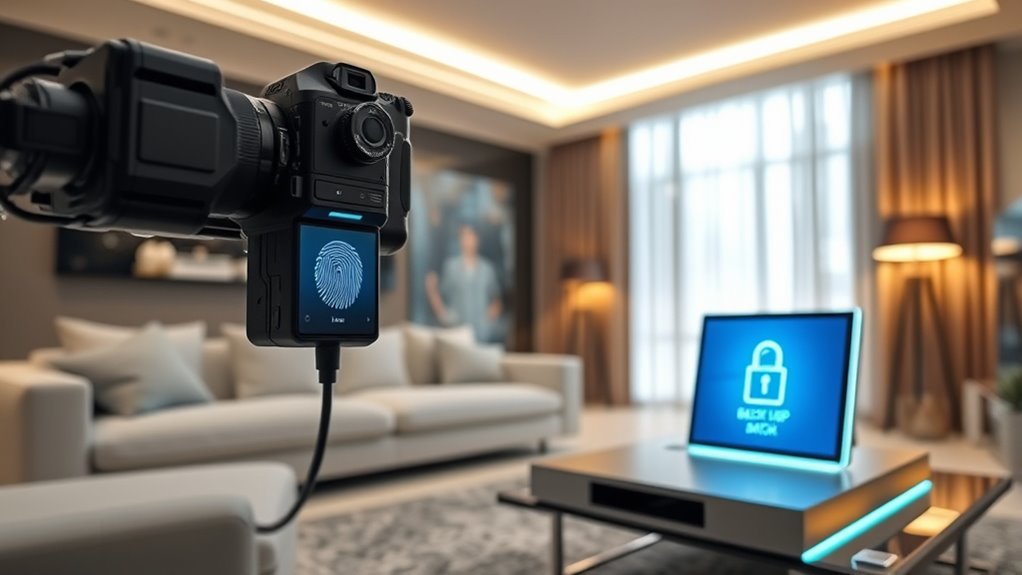
Implementing a thorough backup strategy is essential to guarantee your smart home remains protected against data loss, hardware failures, or cyberattacks. By establishing robust data redundancy, you ensure your critical information stays safe even if devices malfunction or are compromised. Start with these steps:
- Use cloud backup to automatically store copies of your smart home device settings and data off-site.
- Schedule regular backups to keep your data current and minimize potential loss.
- Keep physical backups on external drives as an additional layer of protection.
This multi-layered approach ensures your data is secure, accessible, and recoverable when needed. A complete backup strategy safeguards your smart home’s digital ecosystem against unexpected threats or failures, maintaining peace of mind.
Stay Informed About Security Best Practices and Threats
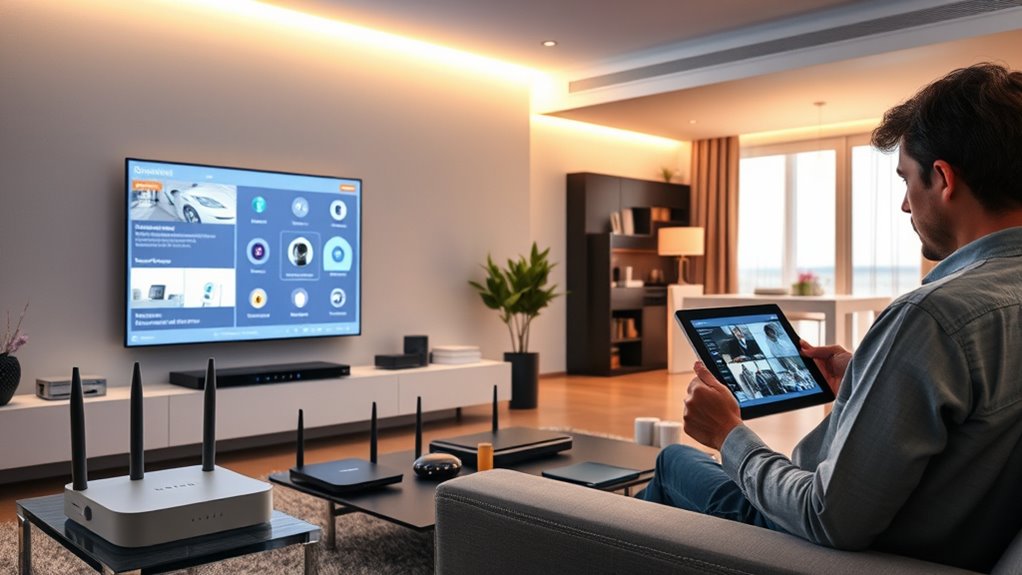
Staying informed about security best practices and emerging threats is essential for maintaining your smart home’s safety. Cybercriminals continuously develop new attack methods, making threat intelligence crucial for staying ahead. Regularly update your knowledge through trusted sources like cybersecurity blogs, official advisories, and industry news. This helps you recognize emerging threats before they impact your devices. Implement security best practices such as changing default passwords, enabling two-factor authentication, and keeping firmware current. By staying proactive and aware of the latest security trends, you reduce your smart home’s vulnerability. Continuously educating yourself ensures you’re prepared to adapt your defenses against evolving threats and protect your devices, data, and privacy effectively. Staying informed is a vital part of a comprehensive smart home security strategy.
Frequently Asked Questions
How Can I Identify if My Smart Home Devices Have Been Compromised?
To identify if your smart home devices have been compromised, start by monitoring unusual network traffic or device behavior. Check if firmware updates are recent and successfully installed, as outdated firmware can be vulnerable. Look for unexpected device activity or slow performance, which could indicate hacking. Regularly review your device settings and network logs to spot anomalies, and guarantee your devices are kept current with the latest firmware updates for better security.
Are There Specific Brands More Vulnerable to Hacking Than Others?
You wonder if some brands are more vulnerable to hacking than others. Brand vulnerabilities vary, but researching device security rankings helps you spot weak links. Look for brands with a history of security flaws, poor update practices, or weak encryption. By comparing these factors, you can choose smarter, more secure devices. Remember, staying informed about brand vulnerabilities helps you protect your smart home from potential threats.
What Are the Signs of a Smart Home Breach or Intrusion?
You should watch for signs of a smart home breach, like unauthorized access or suspicious activity. If your devices start acting strangely, like unusual network traffic or unexpected device behavior, it’s a red flag. You might notice alerts from security apps or unfamiliar devices in your network. Staying vigilant helps you catch breaches early, so you can take action and keep your smart home secure.
Can Using Third-Party Security Apps Improve My Smart Home Safety?
Think of your smart home as a fortress; third-party apps can be like trusted guards, but they sometimes have vulnerabilities that open gates for intruders. Using these apps can improve safety if they employ robust data encryption methods, sealing off sensitive info. However, beware of third-party app vulnerabilities, which might give hackers a backdoor. Choose reputable apps with strong security measures to keep your smart home truly secure.
How Often Should I Perform Security Audits on My Smart Devices?
You should perform security audits on your smart devices at least once every three to six months. During these audits, check device firmware updates to fix vulnerabilities and review user access permissions to make certain only trusted individuals have control. Regularly updating firmware and managing user access helps keep your smart home secure, reducing the risk of unauthorized access and potential hacking attempts. Stay proactive to maintain your smart home’s safety.
Conclusion
By securing your smart home, you create a fortress instead of leaving the door open. Imagine your devices as trusted allies, standing guard against hackers lurking in the shadows. With vigilant updates and strong passwords, you’re building walls that keep intruders at bay. Just as a well-lit home deters burglars, a protected network shields your privacy. Take action today—turn your smart home from a tempting target into an impenetrable sanctuary.

